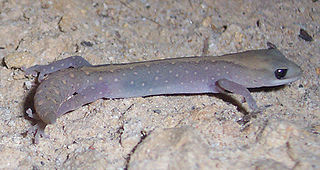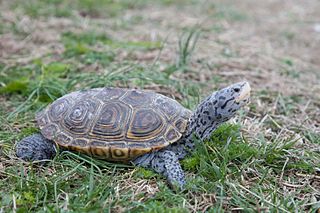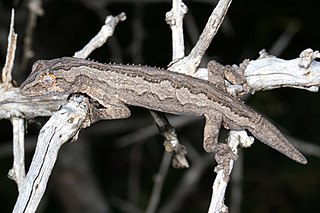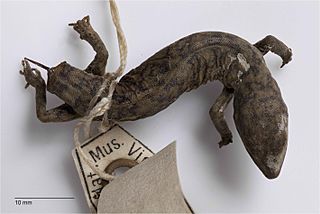
Diplodactylus is a genus of geckos of the family Diplodactylidae from Australia. They are sometimes called stone geckos or fat-tailed geckos. Member species are morphologically similar but genetically distinct.

The beaded gecko is a gecko endemic to Australia.

Rhacodactylus leachianus, commonly known as the New Caledonian giant gecko or Leach's giant gecko or colloquially Leachie, is a large species of gecko in the family Diplodactylidae. The species, which was first described by Georges Cuvier in 1829, is endemic to New Caledonia.

The common leopard gecko is a cathemeral, ground-dwelling lizard native to the rocky dry grassland and desert regions of Afghanistan, Pakistan, north-west India, and Iran. The common leopard gecko has become a popular pet, and due to extensive captive breeding is sometimes referred to as the first domesticated species of lizard.
The western beaked gecko is a species of gecko found throughout the interior of Australia.

The diamondback terrapin or simply terrapin is a species of turtle native to the brackish coastal tidal marshes of the eastern and southern United States, and in Bermuda. It belongs to the monotypic genus Malaclemys. It has one of the largest ranges of all turtles in North America, stretching as far south as the Florida Keys and as far north as Cape Cod.

The Australian flatback sea turtle is a species of sea turtle in the family Cheloniidae. The species is endemic to the sandy beaches and shallow coastal waters of the Australian continental shelf. This turtle gets its common name from the fact that its shell has a flattened or lower dome than the other sea turtles. It can be olive green to grey with a cream underside. It averages from 76 to 96 cm in carapace length and can weigh from 70 to 90 kg. The hatchlings, when emerging from nests, are larger than other sea turtle hatchlings when they hatch. The flatback turtle is listed by the IUCN Red List of Threatened Species as data deficient, meaning there is insufficient scientific information to determine its conservation status at this time. It was previously listed as vulnerable in 1994. It is not as threatened as other sea turtles due to its small dispersal range.

Diplodactylus vittatus, known as the wood gecko or eastern stone gecko is a small gecko found in New South Wales and Queensland. It usually eats insects around dusk, and shelters under cover during the day. When threatened, this species opens its mouth and stands up on all four legs. The eastern stone gecko reproduces during spring and summer. They have a maximum clutch size of two eggs but can have multiple clutches throughout the breeding season.

The Diplodactylidae are a family in the suborder Gekkota (geckos), with about 137 species in 25 genera. These geckos occur in Australia, New Zealand, and New Caledonia. Three diplodactylid genera have recently been split into multiple new genera
Lucasium steindachneri, commonly called the box-patterned gecko or Steindachner's gecko, is a species of nocturnal, medium-sized lizard in the family Diplodactylidae. The species has a pale strip with three patches of brown along its back. This gecko is terrestrial and only found in arid and semi-arid areas of continental Australia.

The northern spiny-tailed gecko is a species of lizard in the family Diplodactylidae. The species is endemic to Australia.
Lucasium byrnei, commonly known as the gibber gecko or Byrne's gecko, is a species of small, nocturnal gecko, a lizard in the family Diplodactylidae. The species is endemic to Australia.
Lucasium stenodactylum, also known as the crowned gecko or pale-snouted ground gecko, is a species of gecko from Australia.

Strophurus intermedius, also known commonly as the eastern spiny-tailed gecko or the southern spiny-tailed gecko, is a species of lizard in the family Diplodactylidae. The species is endemic to semi-arid regions of Australia in New South Wales, Northern Territory, South Australia, Victoria and Western Australia, in mallee shrubland and woodland habitats.
Diplodactylus calcicolus, sometimes called the south coast gecko, is a gecko endemic to Australia.

The variable fat-tailed gecko or burrow-plug gecko is a Diplodactylid gecko endemic to central and arid inland areas of Australia. Widespread across the continent, the variable fat-tailed is most commonly found in sandy desert habitats dominated by Spinifex grasses. They have also been bred in captivity by zoos and as pets.
Diplodactylus fulleri, sometimes called the Lake Disappointment ground gecko, is a species of gecko, a lizard in the family Diplodactylidae. The species is endemic to Australia.
Diplodactylus mitchelli, sometimes called commonly the Pilbara stone gecko, is a species of lizard in the family Diplodactylidae. The species is endemic to Australia.

The Canterbury gecko is a gecko found in the South Island of New Zealand. It is also known by the Maori names Waitaha gecko and Moko-pāpā, and as the Brown gecko. They were earlier placed in a different genus and called Hoplodactylus brunneus before further study split the genus Hoplodactylus into six genera, with some groups close to the former Hoplodactylus maculatus “Canterbury” being assigned to the new genus Woodworthia.
The wood mulch-slider or Mueller's three-toed lerista, is a species of lizard belonging to the extensive family Scincidae, a family containing over 1,500 species. The species is found in a diverse range of climates and habitats throughout Western Australia, Northern Territory, Queensland, New South Wales, South Australia and Victoria. Named after the German-born Australian naturalist Baron Ferdinand Jacob Heinrich Müller (1825–1896), the species has been the subject of much morphological and nomenclature debate.












